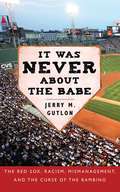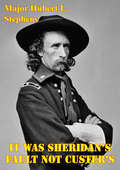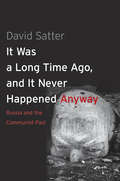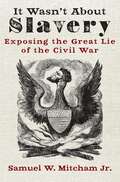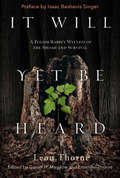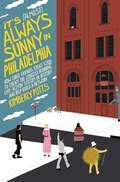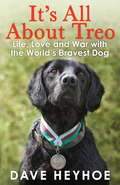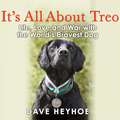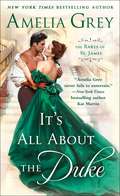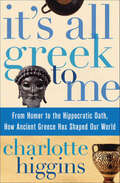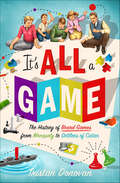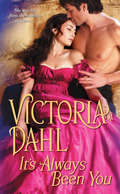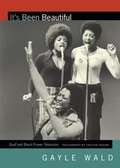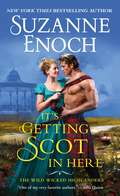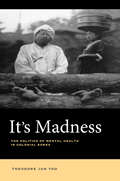- Table View
- List View
It Was Never About the Babe: The Red Sox, Racism, Mismanagement, and the Curse of the Bambino
by Jerry M. GutlonFor years, Red Sox fans were told that their team was cursed because the Sox sold Babe Ruth to the hated Yankees. But as Jerry Gutlon reveals in It Was Never About the Babe, there is much more drama to Red Sox history than the "Curse of the Bambino." The truth is more shocking than any myth. With the thorough research of a seasoned journalist and the zeal of a lifelong Red Sox fan, Gutlon explains why the Sox came up short season after season: ownership chose managers and players not based on their talent, but on whom they drank with; before and after baseball integrated, personal and institutional racism affected their decision-making; and their teams consistently lacked the talent, leadership, chemistry, and luck needed to win championships. Most fans don't know that Babe Ruth was sold not just to produce a Broadway play, bust also because commissioner Ban Johnson was trying to run Sox owner Harry Frazee out of baseball and because Ruth was a major disruption in the Sox clubhouse. They will be surprised to learn that Jackie Robinson tried out at Fenway Park and shocked to learn that much-admired Tom Yawkey, along with owning the Red Sox, also owned a brothel for decades. Covering the early Red Sox championship dynasty of Ruth, the never-good-enough teams of Ted Williams, Carl Yastrzemski, and Carlton Fisk and Curt Schilling, It Was Never About the Babe is an eye-opening read for every baseball fan, and a must-own book for every fan in Boston.
It Was Sheridan's Fault Not Custer's: And The Ties To Current Planning
by Major Hubert L. StephensMartin van Creveld, a noted theorist, contends that the concept of operational art did not take off in the U.S. until after the Vietnam War. Conversely, James Schneider, a prominent military theorist, asserts that operational art began in the American Civil War. This monograph provides a holistic analysis of four Plains Indian War Campaigns. Lieutenant General (LTG) Philip Sheridan conducted all four campaigns. This analysis illustrates several enduring principles of both operational art and counterinsurgency (COIN) operations. The purpose of the monograph is to explain the initial failure of LTG Sheridan's 1876 Centennial Campaign against the Sioux and Cheyenne Indians. Additionally, this explanation relates the significance of LTG Sheridan's planning to contemporary COIN campaign planning. The overall methodology is the incorporation of four case studies to test the theory of sanctuary control and elimination of resources to defeat insurgencies.The monograph contains three key findings. The first key finding is that the failure at the Little Big Horn was LTG Sheridan's fault not LTC Custer's, and this directly relates to the second finding. The second key finding is the importance of operational art in designing a campaign plan to link tactical actions to strategic objectives. The third finding is the efficacy of some of the current COIN tenets...Ultimately, this monograph demonstrates the utility of a strategy of exhaustion and its resulting operations to control terrain and insurgent sanctuaries as well as to deny the enemy resources to defeat an insurgency.
It Was Vulgar and It Was Beautiful: How AIDS Activists Used Art to Fight a Pandemic
by Jack LoweryShortlisted for the J. Anthony Lukas PrizeThe story of art collective Gran Fury—which fought back during the AIDS crisis through direct action and community-made propaganda—offers lessons in love and grief. In the late 1980s, the AIDS pandemic was annihilating queer people, intravenous drug users, and communities of color in America, and disinformation about the disease ran rampant. Out of the activist group ACT UP (AIDS Coalition to Unleash Power), an art collective that called itself Gran Fury formed to campaign against corporate greed, government inaction, stigma, and public indifference to the epidemic. Writer Jack Lowery examines Gran Fury&’s art and activism from iconic images like the &“Kissing Doesn&’t Kill&” poster to the act of dropping piles of fake bills onto the trading floor of the New York Stock Exchange. Lowery offers a complex, moving portrait of a collective and its members, who built essential solidarities with each other and whose lives evidenced the profound trauma of enduring the AIDS crisis. Gran Fury and ACT UP&’s strategies are still used frequently by the activists leading contemporary movements. In an era when structural violence and the devastation of COVID-19 continue to target the most vulnerable, this belief in the power of public art and action persists.
It Was a Long Time Ago, and It Never Happened Anyway: Russia and the Communist Past
by David SatterA veteran writer on Russia and the Soviet Union explains why Russia refuses to draw from the lessons of its past and what this portends for the future Russia today is haunted by deeds that have not been examined and words that have been left unsaid. A serious attempt to understand the meaning of the Communist experience has not been undertaken, and millions of victims of Soviet Communism are all but forgotten. In this book David Satter, a former Moscow correspondent and longtime writer on Russia and the Soviet Union, presents a striking new interpretation of Russia's great historical tragedy, locating its source in Russia's failure fully to appreciate the value of the individual in comparison with the objectives of the state. Satter explores the moral and spiritual crisis of Russian society. He shows how it is possible for a government to deny the inherent value of its citizens and for the population to agree, and why so many Russians actually mourn the passing of the Soviet regime that denied them fundamental rights. Through a wide-ranging consideration of attitudes toward the living and the dead, the past and the present, the state and the individual, Satter arrives at a distinctive and important new way of understanding the Russian experience.
It Wasn't About Slavery: Exposing the Great Lie of the Civil War
by Samuel W. Mitcham Jr.Was the Civil War really about slavery? Or was it a war fought over money? Civil War historian Samuel Mitcham (Vicksburg, Bust Hell Wide Open) opens his fascinating new book It Wasn't About Slavery with Dr. Grady McWhiney's claim that "what passes as standard American history is really Yankee history written by New Englanders or their puppets to glorify Yankee heroes and ideals." Relying on 19th century sources, Mitcham lays out his case that slavery was not the primary cause of the Civil War and that the Civil War narrative taught in schools today is wildly misleading.
It Will Yet Be Heard: A Polish Rabbi's Witness of the Shoah and Survival
by Leon ThorneNobel laureate Isaac Bashevis Singer once described Dr. Leon Thorne’s memoir as a work of “bitter truth” that he compared favorably to the works of Tolstoy, Dostoevsky, and Proust. Out of print for over forty years, this lost classic of Holocaust literature now reappears in a revised, annotated edition, including both Thorne’s original 1961 memoir Out of the Ashes: The Story of a Survivor and his previously unpublished accounts of his arduous postwar experiences in Germany and Poland. Rabbi Thorne composed his memoir under extraordinary conditions, confined to a small underground bunker below a Polish peasant’s pigsty. But, It Will Yet Be Heard is remarkable not only for the story of its composition, but also for its moral clarity and complexity. A deeply religious man, Rabbi Thorne bore witness to forced labor camps, human degradation, and the murders of entire communities. And once he emerged from hiding, he grappled not only with survivor’s guilt, but also with the lingering antisemitism and anti-Jewish violence in Poland even after the war ended. Harrowing, moving, and deeply insightful, Rabbi Thorne’s firsthand account offers a rediscovered perspective on the twentieth century’s greatest tragedy.
It's (Almost) Always Sunny in Philadelphia: How Three Friends Spent $200 to Create the Longest-Running Live-Action Sitcom in History and Help Build a Network
by Kimberly PottsIn the bestselling traditions of Seinfeldia and Top of the Rock comes a fascinating deep dive into the longest-running live-action sitcom in television history, from its humble beginnings to its evolution as a critically acclaimed cult classic comedy.Charlie, Dennis, Mac, Sweet Dee, and Frank are deplorable characters. They will never mature, become more self-aware, or less self-involved. That is what the creators of It&’s Always Sunny in Philadelphia are committed to—and that&’s why the show&’s millions of devoted fans have stuck with the cult comedy hit for over sixteen seasons and counting. Created in 2005 by stars Rob McElhenney, Glenn Howerton, and Charlie Day, unemployed actors with a pair of Law & Order guest appearances as the highlights of their collective resume, the frustrated trio drafted a homemade TV pilot. A few months and $200 later (the cost of videotapes, pizza for their friends who volunteered as extras, and a broomstick to tape their boom mic to), It&’s Always Sunny in Philadelphia was ready for its network debut. All major parties either passed or were interested but wanted creative control. And then came FX looking to shake up cable TV. Willing to allow McElhenney, Howerton, and Day complete freedom to deconstruct the traditional sitcom, new president John Landgraf agreed to take a chance. No one had any idea how big of a success it would be. With FX&’s one creative note—the hiring of Danny DeVito—adding the final piece of the puzzle, It&’s Always Sunny in Philadelphia has enjoyed a steady climb to high ratings, critical acclaim, and a place in the cultural zeitgeist. Now, how the show and its creators have accomplished this is revealed with this in-depth, behind-the-scenes celebration. As thoughtful, provocative, and engaging as the show itself, this book also explores how the show has pushed the envelope and used absurdist comedy to explore major societal issues, including the #MeToo movement, LGBTQ+ rights, racism, and more. It also asks, what does the future hold for The Gang? It certainly won&’t include the characters&’ personal growth, but the show itself continues to move forward, adding to its dynamic history with each season.
It's Alive! The Science of B-Movie Monsters
by Michael LabarberaThe B-movie monster--be it gap-toothed gorilla, ripped-from-time dinosaur, overstretched arachnid, or another outrageous anthropomorphic fantasy--has thrilled moviegoers for decades, and firmly sunk its claws into popular culture. In It's Alive!, Michael LaBarbera delves into the science behind these characters' construction, from the biology surrounding tyrannosaurid postures in Jurassic Park and King Kong to the questionable physics employed by The Incredible Shrinking Man. Accompanied by a treasure trove of images from old movie posters and stills, and ranging from the 1930s to such recent films as The Lord of the Rings trilogy and the latest installments of the Alien franchise, It's Alive! cleverly uses science to remind us that the best parts of moviemaking might indeed be magic-for all creatures, great and small.
It's All About Treo: Life and War with the World's Bravest Dog
by Damien Lewis Dave HeyhoeThis is the incredible true story of the unbreakable bond forged between Treo, the world's most highly decorated dog, and his handler Sgt. Dave HeyhoeWhen Dave Heyhoe was sent to Afghanistan to help detect the Taliban's murderous roadside bombs, he knew he'd need a special dog by his side. Luckily for him, his closest pal Treo, a staggeringly brave ball of energy and mischief was with him every step of the way. The two friends had a miraculous understanding that helped them save countless lives but, as they embarked on a roller-coaster emotional ride, Dave realized he needed Treo more than he could ever have imagined. Tear-jerkingly sad one moment, laugh-out-loud hilarious the next, It's All About Treo is a moving and uplifting story that will melt the hearts of animal lovers everywhere.
It's All About Treo: Life and War with the World's Bravest Dog
by Damien Lewis Dave HeyhoeWhen Dave Heyhoe was sent to Afghanistan to help detect the Taliban's murderous roadside bombs, he knew he'd need a special dog by his side. Luckily for him, his closest pal Treo, a staggeringly brave ball of energy and mischief was with him every step of the way. The two friends had a miraculous understanding that helped them save countless lives but, as they embarked on a roller-coaster emotional ride, Dave realized he needed Treo more than he could ever have imagined. Tear-jerkingly sad one moment, laugh-out-loud hilarious the next, It's All About Treo is a moving and uplifting story that will melt the hearts of animal lovers everywhere. (P)2013 Quercus Publishing Plc / WF Howes
It's All About the Duke: The Rakes of St. James (The Rakes of St. James #3)
by Amelia Grey“A master storyteller.”—Affaire de CoeurNearing thirty, the Duke of Rathburne is finally ready to make amends for the wager that caused him and his best friends such scandal—but taking on a ward who needs a husband is a feat he’s not sure he can manage. The last he saw of Miss Marlena Fast, she was a spirited little ruffian, not the sort of bride most bachelors on the marriage mart sought. But one glance at the lovely lady she has become is enough to convince him otherwise… Orphaned young and shuffled from family to family, Marlena counts on her fierce independence and quick wits to keep herself content. Being the responsibility of a notoriously wicked duke who upended so many lives is an unexpected challenge when she realizes he arouses her decidedly feminine desires. Marlena must be careful. She has her own scandalous secret to protect. If he finds out, will it shatter her chances of a happily-ever-after with the notorious rake?It's All About the Duke is the next Regency romance in The Rakes of St. James series from Amelia Grey.
It's All Greek To Me: From Homer to the Hippocratic Oath, How Ancient Greece Has Shaped Our World
by Charlotte HigginsA lively look at the influence of Ancient Greece on contemporary culture—“A primer, lavish lecture and love song” (Kirkus Reviews).Why is ancient Greece important? Because, quite simply, if we want to understand the modern Western world, we need to look back to the Greeks. Consider the way we think about ethics, about the nature of beauty and truth, about our place in the universe, about our mortality. All this we have learned from the ancient Greeks. They molded the basic disciplines and genres in which we still organize thought, from poetry to drama, from medicine to philosophy, from history to ethnography.Packed with useful facts, including a timeline, a “mythology for dummies,” a who’s who, a guide to Homer’s epics, and a handy map for those struggling to know their Lemnos from their Lesbos, It’s All Greek to Me is an entertaining and insightful tour through the world of the ancient Greeks. Why are some laws Draconian? What is an Achilles’ heel? Why were the Spartans spartan? Charlotte Higgins provides these answers and more, arming average readers with the knowledge they need to understand the Greeks and their tremendous contributions to our lives. This book aims to unlock the richness of a fascinating culture and place it where it should be—in the mainstream of life.
It's All a Game: The History of Board Games from Monopoly to Settlers of Catan
by Tristan Donovan“[A] timely book . . . a wonderfully entertaining trip around the board, through 4,000 years of game history.” —The Wall Street JournalBoard games have been with us even longer than the written word. But what is it about this pastime that continues to captivate us well into the age of smartphones and instant gratification?In It’s All a Game, Tristan Donovan, British journalist and author of Replay: The History of Video Games, opens the box on the incredible and often surprising history and psychology of board games. He traces the evolution of the game across cultures, time periods, and continents, from the paranoid Chicago toy genius behind classics like Operation and Mouse Trap, to the role of Monopoly in helping prisoners of war escape the Nazis, and even the scientific use of board games today to teach artificial intelligence how to reason and how to win. With these compelling stories and characters, Donovan ultimately reveals why board games—from chess to Monopoly to Risk and more—have captured hearts and minds all over the world for generations.“Splendid . . . A quick and breezy read, it doesn’t just tell the fascinating stories of the (often struggling) individuals who created our favorite games. It also manages to convey the entire sweep of board game history, from the earliest forms of checkers to modern-day surprise hits like Settlers of Catan.” —Mashable“Artfully weaves together culture, business, and ways games impact society.” —Booklist“A fascinating and insightful discussion not only of games past, but the socioeconomic and historical factors that contributed to their popularity.” —Chicago Review of Books
It's Always Been You (The York Family #2)
by Victoria DahlOnce She Slipped Through His Fingers...Aidan York has spent ten years mourning the woman he once loved and lost. He's filled the void in the only way he knows-by distracting himself with wild behavior and scandalous trysts. It's a hollow existence, but it dulls the pain. Until the day he encounters a ghost: the woman he thought drowned at sea, alive and as enchanting as ever...Now He'll Keep Her In His Arms....When Kate Hamilton sees the man she once hoped to spend her life with, she is hit with a storm of memories and longing. But though resisting Aidan's passion proves impossible, Kate must try not to love him all over again. For her seemingly quiet London life shields a dangerous secret, one that will catch up to her the moment she lets herself fall...
It's Been Beautiful: Soul! and Black Power Television
by Gayle WaldSoul! was where Stevie Wonder and Earth, Wind & Fire got funky, where Toni Morrison read from her debut novel, where James Baldwin and Nikki Giovanni discussed gender and power, and where Amiri Baraka and Stokely Carmichael enjoyed a sympathetic forum for their radical politics. Broadcast on public television between 1968 and 1973, Soul!, helmed by pioneering producer and frequent host Ellis Haizlip, connected an array of black performers and public figures with a black viewing audience. In It's Been Beautiful, Gayle Wald tells the story of Soul!, casting this influential but overlooked program as a bold and innovative use of television to represent and critically explore black identity, culture, and feeling during a transitional period in the black freedom struggle.
It's Better Than It Looks: Reasons for Optimism in an Age of Fear
by Gregg EasterbrookIs civilization teetering on the edge of a cliff? Or are we just climbing higher than ever?Most people who read the news would tell you that 2017 is one of the worst years in recent memory. We're facing a series of deeply troubling, even existential problems: fascism, terrorism, environmental collapse, racial and economic inequality, and more.Yet this narrative misses something important: by almost every meaningful measure, the modern world is better than it ever has been. In the United States, disease, crime, discrimination, and most forms of pollution are in long-term decline, while longevity and education keep rising and economic indicators are better than in any past generation. Worldwide, malnutrition and extreme poverty are at historic lows, and the risk of dying by war or violence is the lowest in human history.It's not a coincidence that we're confused--our perspectives on the world are blurred by the rise of social media, the machinations of politicians, and our own biases. Meanwhile, political reforms like the Clean Air Act and technological innovations like the hybridization of wheat have saved huge numbers of lives. In that optimistic spirit, Easterbrook offers specific policy reforms to address climate change, inequality, and other problems, and reminds us that there is real hope in conquering such challenges. In an age of discord and fear-mongering, It's Better Than It Looks will profoundly change your perspective on who we are, where we're headed, and what we're capable of.
It's Elemental: The Hidden Chemistry in Everything
by Kate BiberdorfIn this fresh and engaging guide to chemistry, Dr. Kate Biberdorf, aka "Kate the Chemist," reveals the fascinating science we experience every day Have you ever wondered what makes dough rise? Or how your morning coffee gives you that energy boost? Or why your shampoo is making your hair look greasy? The answer is chemistry. From the moment we wake up until the time we go to sleep (and even while we sleep), chemistry is at work—and it doesn't take a PhD in science to understand it. Dr. Biberdorf has appeared on TV programs from the Today show to The Late Show with Stephen Colbert, lighting the world on fire and changing the face of chemistry as we know it. In It's Elemental, she demystifies the fundamental principles of the science that may have eluded you in high school and shows how chemistry comes alive in everything we do. With wry wit and infectious enthusiasm, this entertaining guide will ignite your passion for science and change the way you experience the world.
It's Getting Hot in Here: The Past, Present, and Future of Climate Change
by Bridget HeosTackling the issue of global warming head-on for a teen audience, Bridget Heos examines the science behind it, the history of climate change on our planet, and the ways in which humans have affected the current crisis we face. It's Getting Hot in Here illustrates how interconnected we are not just with everyone else on the planet, but with the people who came before us and the ones who will inherit the planet after us. This eye-opening approach to one of today's most pressing issues focuses on the past human influences, the current state of affairs, the grim picture for the future--and how young readers can help to make a positive change.
It's Getting Scot in Here (The Wild Wicked Highlanders #1)
by Suzanne EnochThree brides for three wild and wicked Highlanders…Meet the wild, wicked, [ready-to-wed ] MacTaggert brothers, who must find a London-bred bride or lose the Highland home they love, in this sparkling new Scottish historical romance series from New York Times and USA Today bestselling author Suzanne Enoch! “It’s time to fall in love with Suzanne Enoch.” — Lisa KleypasA hellion? Or heaven-sent?Rugged Highlander Niall MacTaggert and his brothers know the stakes: The heir must marry a London lass of their mother’s choosing or lose their ancestral estate. But Niall’s eldest brother shows no interest in the lady selected. Is it because Amelia-Rose is too independent? Free-spirited? Outspoken? Frankly, Niall admires her for all the reasons his brother doesn’t, but surely he can find a way to soften up the whip-smart lass and make her the perfect, demure match… for the sake of the family, of course.The sharper the thorn the sweeter the rose…Amelia-Rose Baxter is the reigning queen of London Society, and she’s nobody's fool. Her parents may insist she catch a title, but she’s got her own vision of the ideal husband: a man who wants more than a pretty face and pretty manners; a man who can appreciate her sharp mind as well as her body; a man who considers her his equal—a sophisticated man who loves London life and won’t try to tame her wild heart...Happily whatever after!Yet she can’t seem to resist rugged, plain-spoken Niall, despite her reservations about barbarian Highlanders. Niall is finding the lass nigh irresistible as well, but he’s seen the mistake his father made in marrying an Englishwoman who doesn’t like the Highlands. The odds against true love are enormous… then again, the bigger the risk, the better the reward!
It's Getting Scot in Here (The Wild Wicked Highlanders #1)
by Suzanne EnochThe first in a wickedly seductive new Scottish historical romance series from New York Times bestselling author Suzanne Enoch! “It’s time to fall in love with Suzanne Enoch.” — Lisa KleypasHAPPILY-EVER-AFTERLondon socialite Amelia-Rose Baxter is nobody’s fool. Her parents may want her to catch a title, but she will never change who she is for the promise of marriage. Her husband will be a man who can appreciate her sharp mind as well as her body. A sophisticated man who loves life in London. A man who considers her his equal—and won’t try to tame her wild heart...IN THE HIGHLANDSRough, rugged Highlander Niall MacTaggert and his brothers know the rules: the eldest must marry or lose the ancestral estate, period. But Niall’s eldest brother just isn’t interested in the lady his mother selected. Is it because Amelia-Rose is just too. . . Free-spirited? Yes. Brazen? Aye. Surely Niall can find a way to soften up the whip-smart lass and make her the perfect match for his brother for the sake of the family.JUST GOT A WHOLE LOT HOTTER.Instead it’s Niall who tempts Amelia-Rose, despite her reservations about barbarian Highlanders. Niall finds the lass nigh irresistible as well, but he won’t make the mistake his father did in marrying an Englishwoman who doesn’t like the Highlands. Does he have what it takes to win her heart? There is only one way to find out...
It's Hard Out Here for a Duke: Keeping Up with the Cavendishes (Keeping Up With The Cavendishes Ser. #4)
by Maya RodaleA newly minted duke is determined to have the beautiful commoner he will never forget in this sexy Regency romance series finale.When American-born James Cavendish arrives in London tomorrow, he’ll become the Duke of Durham. Some might be ecstatic at the opportunity. Not James. He’s a simple man, fond of simple pleasures. And right now, nothing could be more pleasurable than spending his last night of freedom with a beautiful stranger.One wild night, Meredith Green, companion to the dowager Duchess of Durham, said yes to a man she thought she’d never see again. Suddenly, they’re living under the same roof, where Meredith is expected to teach James how to be a duke—while trying not to surrender to temptation a second time.For a duke and a commoner, marriage would be pure scandal. Yet nothing has ever felt as right to James as having Meredith in his arms . . . and in his bed. Soon he must choose—between a duty he never desired, and a woman he longs for, body and soul . . .
It's Hard to be Hip Over Thirty and Other Tragedies of Married Life
by Judith ViorstShort book of timely poetry written in 1968. Asterisks between stanzas.
It's In His Kiss: Bridgerton (Bridgertons #7)
by Julia QuinnA New York Times BestsellerFrom #1 New York Times bestselling author Julia Quinn comes the story of Hyacinth Bridgerton, in the seventh of her beloved Regency-set novels featuring the charming, powerful Bridgerton family, now a series created by Shondaland for Netflix.HYACINTH’S STORYMeet Our Hero . . .Gareth St. Clair is in a bind. His father, who detests him, is determined to beggar the St. Clair estates and ruin his inheritance. Gareth’s sole bequest is an old family diary, which may or may not contain the secrets of his past . . . and the key to his future. The problem is—it’s written in Italian, of which Gareth speaks not a word.Meet Our Heroine . . .All the ton agreed: there was no one quite like Hyacinth Bridgerton. She’s fiendishly smart, devilishly outspoken, and according to Gareth, probably best in small doses. But there’s something about her—something charming and vexing—that grabs him and won’t quite let go . . .Meet Poor Mr. Mozart . . . Or don’t. But rest assured, he’s spinning in his grave when Gareth and Hyacinth cross paths at the annual—and annually discordant—Smythe-Smith musicale. To Hyacinth, Gareth’s every word seems a dare, and she offers to translate his diary, even though her Italian is slightly less than perfect. But as they delve into the mysterious text, they discover that the answers they seek lie not in the diary, but in each other . . . and that there is nothing as simple—or as complicated—as a single, perfect kiss.
It's Madness
by Theodore Jun YooIt's Madness examines Korea's years under Japanese colonialism, when mental health first became defined as a medical and social problem. As in most Asian countries, severe social ostracism, shame, and fear of jeopardizing marriage prospects compelled most Korean families to conceal the mentally ill behind closed doors. This book explores the impact of Chinese traditional medicine and its holistic approach to treating mental disorders, the resilience of folk illnesses as explanations for inappropriate and dangerous behaviors, the emergence of clinical psychiatry as a discipline, and the competing models of care under the Japanese colonial authorities and Western missionary doctors. Drawing upon unpublished archival as well as printed sources, this is the first study to examine the ways in which "madness" was understood, classified, and treated in traditional Korea and the role of science in pathologizing and redefining mental illness under Japanese colonial rule.
It's Marriage or Ruin (Mills And Boon Historical Ser. #1)
by Liz TynerA spinster artist desperate to avoid marriage finds herself forced to marry a rakish lord in this witty historical romance.Miss Emilie Catesby lives to paint, but when her mother threatens to take her oils away if she doesn’t marry, she must either recklessly ruin herself, or marry jaded Lord Marcus. And when she finds herself compromised into a marriage of convenience with Marcus, her decision is made for her! However, she’s now surprised to discover her wifely duties hold much more appeal than her paints . . .“What I love about Ms. Tyner’s work [is that] she takes what is a very basic trope and storyline and gives it a twist and it ends up being fresh and new.” —Chicks, Rogues and Scandals on To Win a Wallflower
